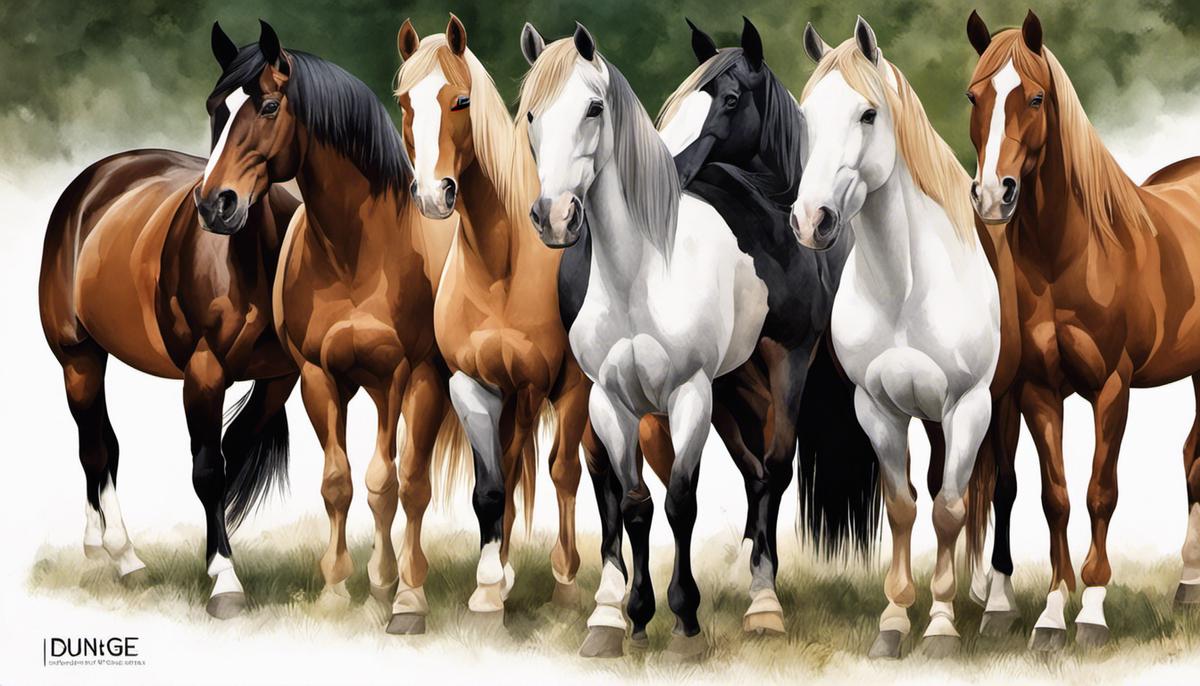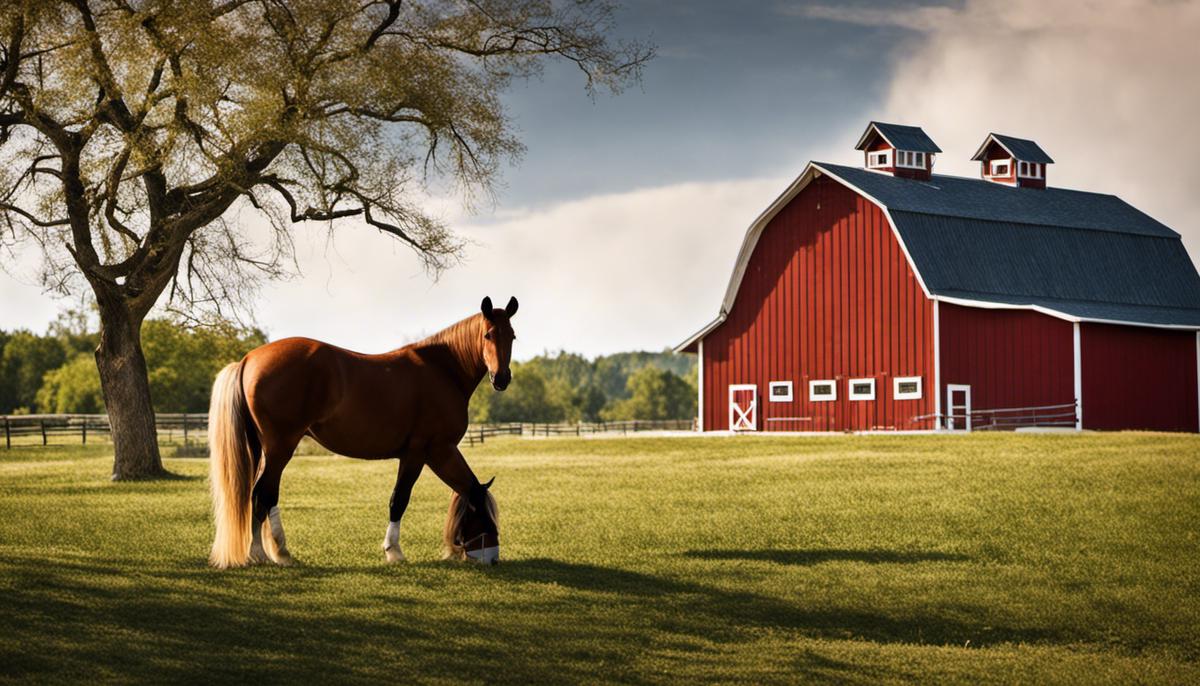In the fascinating world of equines, Dun Horses hold a unique and arresting presence, mesmerizing observers with their distinctive coat coloring and markings. One can identify these horses by their unusual dun color, which comes in three delightful variations — Classic Dun, Red Dun, and Grullo. However, understanding these intricate colorations involves awareness of the physical features that distinguish Dun Horses from others, including a conspicuous dorsal stripe, enigmatic shoulder blade stripes, and leg barring. The rareness of this blend makes it all the more captivating, yet it falls prey to frequent confusion with other colors, underscoring the importance of careful inspection and genetic testing. But color alone does not paint a complete picture of the Dun Horse. The key to fully appreciate these equids lies in comprehending the genetics influencing the Dun color, learning the optimal ways to handle their care and wellbeing, along with understanding how the unique Dun coloring can influence various aspects of their grooming and care products.
Table of Contents (Horspedia)
Understanding the Dun Horse Color
Understanding the Dun Horse: The Coat Color Genetics
A Dun Horse refers to a horse with specific coat color genetics that reflect a particular pigment dilution. The phenomenon is mainly due to the Dun gene that lightens the horse’s coat, while the head, lower legs, mane, and tail retain the original dark color. This contrast creates a distinctive two-toned appearance, setting Dun horses apart. The color variations associated with the Dun gene primarily result from the interplay of other color genes.
Different Variations of the Dun Horse
Typically, there are three basic variations of Dun Horses, that is, Classic Dun, Red Dun, and Grullo. The Classic Dun, most commonly referred to as Bay Dun, have a tan or gold body with a black mane, tail, and primitive markings.
Red Duns have a coat color ranging from light peach to reddish tan, with the mane, tail, and primitive markings in a darker shade of red or brown. The Grullo, characterized by a smoky or mouse-colored body with black primitive markings. Their unique coat may sometimes be tinged with a silvery cast.
Physical Features & Primitive Markings
Dun Horses exhibit primitive markings, which include a dorsal stripe running down the middle of their back, shoulder blade stripes that extend down to the withers area, leg barring or ‘zebra stripes’ around the knees and hocks, ear tips that are outlined in darker color, and cobwebbing on the forehead. These markings are more intensely pigmented than the rest of the coat and aren’t typically seen in non-dun horses.
Apart from the markings, Dun Horses also possess a unique hair structure that differs from other horses. Their hairs are not uniformly pigmented, with lighter and darker bands within each hair, giving the Dun Horse a peculiar glowing appearance.
The Rarity of the Dun Horse and Misidentifications
Despite the striking beauty of Dun Horses, they are relatively rare. Many horses are mistakenly identified as Dun due to resemblance in coat shade. It’s also common to incorrectly label Buckskin horses (which also exhibit a dilution gene called cream, resulting in gold-colored coats and black points) as Dun. However, unless a horse exhibits the primitive markings unique to Dun Horses and tests positive for the Dun gene, it cannot be classified as a Dun.
The Significance of Genetic Testing for Correctly Identifying Dun Horses
Identifying a Dun horse accurately, among similar looking equine, is often a complex task. This is where the crucial role of genetic testing comes in. A DNA test specifically checking for the Dun gene can decisively confirm if a horse is an authentic Dun. Misunderstandings are thus avoided, permitting the pure Dun Horse lineage to be preserved.
When it comes to breeding, it’s crucial to remember that Dun is a dominant gene. If one of the parent horses carries the Dun gene, the chances of the offspring having the Dun color increases significantly. This detail is of fundamental importance for breeders who are focused on propagating Dun Horses.

Genetics of Dun Horse
Demystifying the Dun Gene (D) in Equines
One of the primary genetic factors that determine a horse’s coat color is the Dun gene, commonly known as ‘D’. Its dominant variant, depicted as ‘D’, is the part that waters down the horse’s basic coat color. On the other hand, its recessive counterpart, symbolized as ‘d’, doesn’t affect the color at all. Essentially, the Dun coat color is a diluted version with pattern changes that lighten most of the body but leaves the primitive markings darker than the rest of the coat.
The Role of the Dun Gene
The Dun gene affects how the pigment is distributed in individual hairs. It dilutes the base color of the horse by lightening the hair’s pigment over most parts of the body, except some areas such as the mane, tail, and primitive markings. The primitive markings refer to patterns that include the dorsal stripe, shoulder stripe, leg barring, and cobwebbing on the forehead. Notably, the Dun gene does not alter the color of the pigment itself but changes its distribution, producing a diluted body color with darker contrasting points.
Variations in Dun Horses
The different Dun variations result from the interaction of the Dun gene with various base colors. The three primary Dun color variations are Classic Dun, Red Dun, and Grullo Dun. The Classic Dun combines with a bay base color; Red Dun is a result of the chestnut base, whereas Grullo Dun occurs with a black base color. In every variation, the primitive markings remain darker, offering the blend of color contrast ranging between the base and diluted colors.
The Inheritance of the Dun Gene
Genetics plays a significant role in the inheritance of the Dun gene. As a dominant gene, it means that only one parent horse needs to possess the Dun gene to pass it onto the offspring. Therefore, a Dun-colored horse can have non-Dun parents if they are both carriers of the recessive dun gene. However, two non-dun horses who do not carry the Dun gene will never produce a Dun-colored foal.
Unraveling the Mystique of Dun Horses: Role of Genetic Testing
The crucial key to unlocking the secrets of the Dun coloration in horses lies in genetic testing. This testing process can help establish whether a horse possesses the dominant or recessive Dun gene, or if it doesn’t carry it at all. Such genetic information matters most when breeding horses, especially if the intent is to yield a particular Dun shade. In addition, genetic testing aids in distinguishing true Dun genes from other non-dun dilution genes, which could produce similar-looking dilution effects.

Caring for Dun Horses
Nourishing Dun Horses: Guiding Principles on Feeding
Dun horses, much like their equine counterparts, require a balanced and nutritious diet to sustain their vitality. The feeding regimen generally encompasses fresh grass, high-grade hay, horses’ specially-formulated commercial feed, merged with a consistent supply of fresh, clean water. Nonetheless, it’s essential to tailor the proportions to each unique horse, considering its age, weight, current health status, work level, among other relevant factors.
Potential Health Issues in Dun Horses
While Dun horses are known for their strength and robustness, they can still be susceptible to common equine health issues, including colic, laminitis, respiratory disorders, dental problems, and skin diseases. Regular vet check-ups are crucial to ensure early detection and timely treatment of any health complications.
Grooming Needs for Dun Horses: The Unique Coat Color
Dun horses are distinguished by their distinctive coat color, often in variations of sandy or brownish-yellow hues. Routine grooming is vital to keep the coat healthy and radiant. This includes daily brushing to remove dirt, tangles, and loose hair, along with frequent bathing using horse-safe shampoos.
The Importance of Regular Exercise and Social Interaction
Like all horses, Duns require regular exercise to stay healthy and fit. This can include walking, trotting, running, and other forms of structured activity. Equally important is social interaction. Horses are social animals and need ample opportunity for play and bonding with other horses.
Influence of Dun Coloring on Horse Sunscreen, Detanglers and Fly Sprays
The Dun’s unique coat color can influence the choice of equine sunscreens, detanglers, and fly sprays. Sunscreens should be sufficiently gentle to avoid discolouring the coat. Recommended options include Quic Screen Coat Sunscreen and Farnam’s Laser Sheen Dazzling Shine & Detangler. These products not only protect the coat but also highlight its unique color. The choice of fly sprays should also be suitable for the Dun’s sensitive skin — the Pyranha Wipe N Spray is a frequently recommended option.
By adhering to the basic horse care guidelines and tailoring them to the Dun horse’s unique characteristics, owners can ensure their horses stay healthy, happy, and vibrant.

Understanding and recognizing the Dun Horse extends beyond its remarkable coat color to the genetics causing this distinction. Although the Dun gene dilutes the horse’s base color, the manifestation of a Dun Horse involves intricate inheritance patterns and probabilities. Essentially, each Dun Horse is a product of genetic roulette and distinctly stands as a testament to the power and mystery of genetic inheritance. In addition to this, the significance of being knowledgeable about their grooming and health care cannot be underestimated. Dun Horses have similar basic needs as other equines but require specific considerations due to their unique color. From their food and exercise regimen to their health concerns, selecting suitable sunscreen, detanglers, and fly sprays, caring for a Dun Horse is as complex as it is rewarding. As we increase our understanding of these beautiful horses, we not only gain a greater appreciation for their unique qualities but also enhance our abilities to nurture and care for them effectively.
